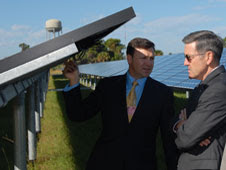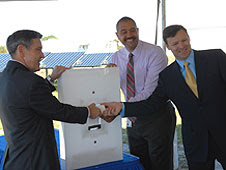NASA's Kennedy Space Center turned a shade greener Nov. 19 with the addition of five acres of electricity-producing solar panels to the spaceport's power grid.
 The Kennedy Solar Energy Center is the first of two new power facilities being built at Kennedy that use solar panels to convert sunlight into electricity. The process creates no carbon emissions and requires no fuel, such as oil or natural gas, to generate power.
The Kennedy Solar Energy Center is the first of two new power facilities being built at Kennedy that use solar panels to convert sunlight into electricity. The process creates no carbon emissions and requires no fuel, such as oil or natural gas, to generate power.
It is the first large-scale power plant of its kind at a NASA center, and part of a small but growing solar infrastructure under development in Florida.
"We are taking a leadership role in supporting an important national goal and that's to increase America's energy independence while protecting the climate," said Bob Cabana, director of Kennedy.
A ceremony commissioning the first of two power plants also offered a glimpse at future projects that could include permanent renewable energy research and development center proposed for Kennedy. A plan to build solar panels on up to 500 acres of fallow agricultural land also is under consideration depending on the environmental and economic feasibility.
 For now, the solar farms under construction help show the way for electricity generation.
For now, the solar farms under construction help show the way for electricity generation.
Built in the center's Industrial Area south of the Vertical Integration Facility, the solar farm is large enough to create one megawatt of electricity, or enough to power 110 homes. For Kennedy, the power output equates to about 1 percent of the center's electricity uses.
A second, much larger, solar energy complex is under construction in a former citrus grove at the south end of the center. That location will produce 10 megawatts of electricity and is scheduled to be finished in April 2010. It will be plugged into FPL's network and distributed to the utility's other customers.
"The fuel for this is always free," said Eric Silagy, FPL vice president and chief development officer. "Solar power is ready to take center stage here in the sunshine state."
SunPower Corp. designed and built the facility by mounting 3,344 panels atop 1,183 piers. The structures are designed to withstand 130 mph winds.
 Compared with a conventionally fueled power plant, the solar energy center is relatively simple. All the panels have to do is let the sun hit them to produce current. It can be monitored remotely and its maintenance needs are expected to be quite small, said Roderick Roche, senior manager in SunPower's program office.
Compared with a conventionally fueled power plant, the solar energy center is relatively simple. All the panels have to do is let the sun hit them to produce current. It can be monitored remotely and its maintenance needs are expected to be quite small, said Roderick Roche, senior manager in SunPower's program office.
The panels are tilted 20 degrees facing south. Their greatest energy producing time will be in April, from 11 a.m. to noon. Predictably, January conditions are the least favorable for power generation, but that won't stop the panels from working even in the winter.
Jim Ball, program manager for Center Development at Kennedy, said it would take a tremendous amount of new solar facilities to fulfill all of the center's electricity requirements, but that may become possible as the technology improves and new efficiencies develop.
"We're in the right place at the right time," Ball said.
 The Kennedy Solar Energy Center is the first of two new power facilities being built at Kennedy that use solar panels to convert sunlight into electricity. The process creates no carbon emissions and requires no fuel, such as oil or natural gas, to generate power.
The Kennedy Solar Energy Center is the first of two new power facilities being built at Kennedy that use solar panels to convert sunlight into electricity. The process creates no carbon emissions and requires no fuel, such as oil or natural gas, to generate power.It is the first large-scale power plant of its kind at a NASA center, and part of a small but growing solar infrastructure under development in Florida.
"We are taking a leadership role in supporting an important national goal and that's to increase America's energy independence while protecting the climate," said Bob Cabana, director of Kennedy.
A ceremony commissioning the first of two power plants also offered a glimpse at future projects that could include permanent renewable energy research and development center proposed for Kennedy. A plan to build solar panels on up to 500 acres of fallow agricultural land also is under consideration depending on the environmental and economic feasibility.
 For now, the solar farms under construction help show the way for electricity generation.
For now, the solar farms under construction help show the way for electricity generation.Built in the center's Industrial Area south of the Vertical Integration Facility, the solar farm is large enough to create one megawatt of electricity, or enough to power 110 homes. For Kennedy, the power output equates to about 1 percent of the center's electricity uses.
A second, much larger, solar energy complex is under construction in a former citrus grove at the south end of the center. That location will produce 10 megawatts of electricity and is scheduled to be finished in April 2010. It will be plugged into FPL's network and distributed to the utility's other customers.
"The fuel for this is always free," said Eric Silagy, FPL vice president and chief development officer. "Solar power is ready to take center stage here in the sunshine state."
SunPower Corp. designed and built the facility by mounting 3,344 panels atop 1,183 piers. The structures are designed to withstand 130 mph winds.
 Compared with a conventionally fueled power plant, the solar energy center is relatively simple. All the panels have to do is let the sun hit them to produce current. It can be monitored remotely and its maintenance needs are expected to be quite small, said Roderick Roche, senior manager in SunPower's program office.
Compared with a conventionally fueled power plant, the solar energy center is relatively simple. All the panels have to do is let the sun hit them to produce current. It can be monitored remotely and its maintenance needs are expected to be quite small, said Roderick Roche, senior manager in SunPower's program office.The panels are tilted 20 degrees facing south. Their greatest energy producing time will be in April, from 11 a.m. to noon. Predictably, January conditions are the least favorable for power generation, but that won't stop the panels from working even in the winter.
Jim Ball, program manager for Center Development at Kennedy, said it would take a tremendous amount of new solar facilities to fulfill all of the center's electricity requirements, but that may become possible as the technology improves and new efficiencies develop.
"We're in the right place at the right time," Ball said.




No comments:
Post a Comment